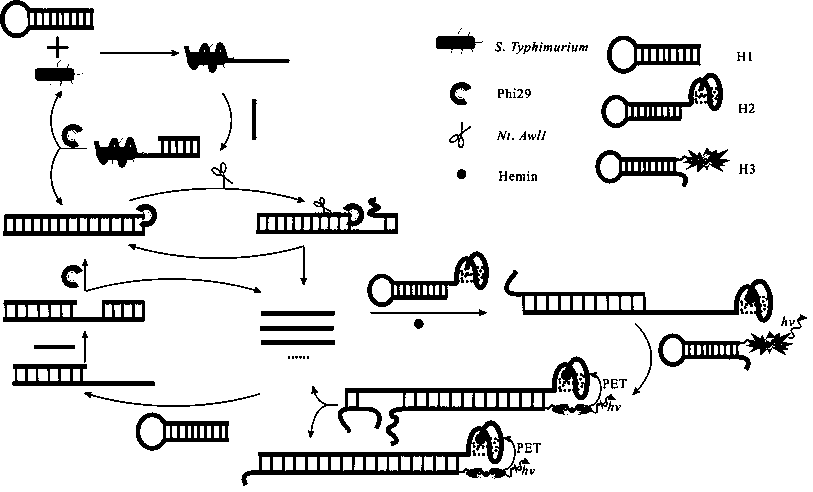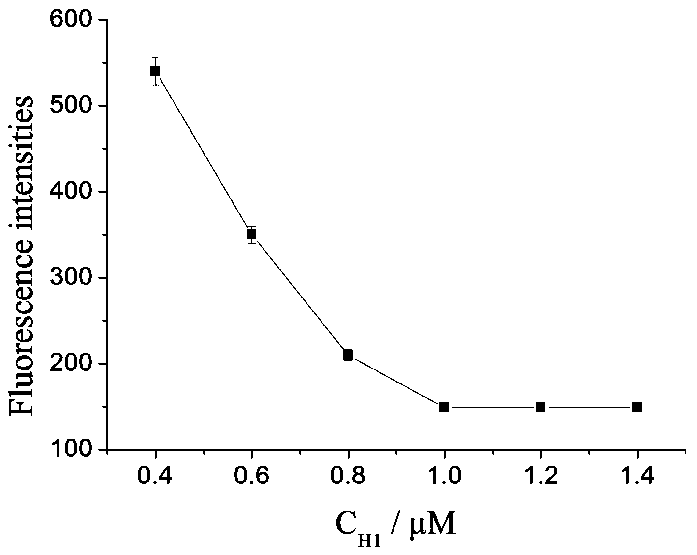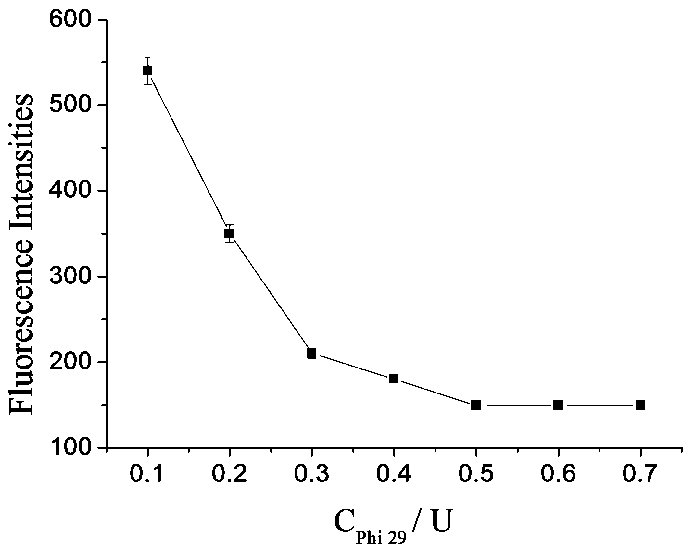A method for detecting Salmonella
A technology for Salmonella and target bacteria, applied in the field of microbial detection, can solve the problems of high cost, low specificity and sensitivity, long detection period, etc., and achieve the effects of low detection limit, improved specific identification, and fast detection speed.
- Summary
- Abstract
- Description
- Claims
- Application Information
AI Technical Summary
Problems solved by technology
Method used
Image
Examples
preparation example Construction
[0042] Described preparation method, the synthetic operation step of preferred DNA silver nanocluster is as follows:
[0043] ① Add 15 μL of 100 μM H3 and 73 μL of 20 mM PB buffer (pH 7.0) into the EP tube wrapped in tinfoil, and then add 6 μL of 1.5 mM AgNO 3 solution (make sure the Ag + The ratio of H3 to H3 is 6:1), shake for 1 min, and place at 4°C for 30 min.
[0044] ② After 30 min, continue to add 6 μL of 1.5 mM NaBH to the EP tube 4 , shaken for 1 min, and placed in the dark at 4 °C for more than 6 h for later use.
[0045] Described preparation method, preferred homogeneous reaction operating steps are as follows:
[0046] H1 (3 μL, 20 μM), Primer (3 μL, 5 μM), Phi 29 polymerase (0.5 U), dNTPs (5 μL), Nt.AlwI endonuclease (0.5 U), H2 (9 μL, 50 μM), heme (5 μL) and H3 (9 μL, 50 μM), 10× buffer solution (buffer10 μL) and 5 μL sterilized water were added to the EP tube wrapped in foil paper, and then 5 μL target After mixing evenly, they were placed in a water bath ...
Embodiment 1
[0050] The preparation method of described fluorescent biosensor comprises the following steps:
[0051] The synthetic operation steps of DNA silver nanoclusters are as follows:
[0052] ① Add 15 μL of 100 μM H3 and 73 μL of 20 mM PB buffer (pH 7.0) into the EP tube wrapped in tinfoil, and then add 6 μL of 1.5 mM AgNO 3 solution (make sure the Ag + The ratio of H3 to H3 is 6:1), shake for 1 min, and place at 4°C for 30 min.
[0053] ② After 30 min, continue to add 6 μL of 1.5 mM NaBH to the EP tube 4 , shaken for 1 min, and placed in the dark at 4 °C for more than 6 h for later use.
[0054] The main steps of the reaction process in homogeneous solution are as follows:
[0055] a. Mix H1 (final concentrations are 0.4 μM, 0.6 μM, 0.8 μM, 1.0 μM, 1.2 μM, 1.4 μM), Primer (3 μL, 5 μM), Phi 29 polymerase (0.5 U), dNTPs (5 μL ), Nt.AlwI endonuclease (0.5 U), H2 (9 μL, 50 μM), heme (5 μL) and H3 (9 μL, 50 μM), 10× buffer (buffer10 μL) and 5 μL Add sterilized water to the EP tub...
Embodiment 2
[0063] The preparation method of described fluorescent biosensor comprises the following steps:
[0064] The synthetic operation steps of DNA silver nanoclusters are as follows:
[0065] ① Add 15 μL of 100 μM H3 and 73 μL of 20 mM PB buffer (pH 7.0) into the EP tube wrapped in tinfoil, and then add 6 μL of 1.5 mM AgNO 3 solution (make sure the Ag + The ratio of H3 to H3 is 6:1), shake for 1 min, and place at 4°C for 30 min.
[0066] ② After 30 min, continue to add 6 μL of 1.5 mM NaBH to the EP tube 4 , shaken for 1 min, and placed in the dark at 4 °C for more than 6 h for later use.
[0067] The main steps of the reaction process in homogeneous solution are as follows:
[0068] a. Mix H1 (3 μL, 20 μM), Primer (3 μL, 5 μM), Phi 29 polymerase (0.1U, 0.2 U, 0.3U, 0.4 U, 0.5 U, 0.6 U, 0.7 U), dNTPs ( 5 μL), Nt.AlwI endonuclease (0.5 U), H2 (9 μL, 50 μM), heme (5 μL) and H3 (9 μL, 50 μM), 10× buffer (buffer10 μL) and Add 5 μL of sterilized water to the EP tube wrapped in tin ...
PUM
 Login to View More
Login to View More Abstract
Description
Claims
Application Information
 Login to View More
Login to View More - R&D
- Intellectual Property
- Life Sciences
- Materials
- Tech Scout
- Unparalleled Data Quality
- Higher Quality Content
- 60% Fewer Hallucinations
Browse by: Latest US Patents, China's latest patents, Technical Efficacy Thesaurus, Application Domain, Technology Topic, Popular Technical Reports.
© 2025 PatSnap. All rights reserved.Legal|Privacy policy|Modern Slavery Act Transparency Statement|Sitemap|About US| Contact US: help@patsnap.com



